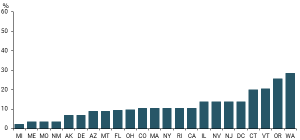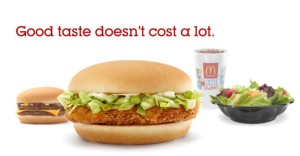In April 2015, over one thousand protestors flooded the University of Southern California campus sporting signs and mega phones. The contingent was primarily made up of fast food workers from the popular chains dotting Figueroa Street seeking a $15 per hour “living” wage. This over 100% increase from the federal minimum wage of $7.25 per hour would have once been unthinkable.
In July 2015, Los Angeles County did the unthinkable by instituting a plan to gradually raise the minimum wage from $9 to $15 per hour by 2022. New York City, Seattle, and Washington D.C. have similar plans (Journalist’s Resource). The minimum wage has long been a hot-button topic in American politics. Democrats tend to support a minimum wage increase, arguing that real-worker pay has unfairly stagnated. There is a long standing concern amongst Republicans that the economic effects of a high minimum wage would reduce profits for businesses and cause businesses to cut employment. Increasing the minimum wage to $15 per hour has potential to force fast food and retail businesses to raise prices and slash labor in order to cut costs.
The minimum wage was first enacted in 1938 as part of the Fair Labor Standards Act to keep money in struggling workers’ pockets (Journalist’s Resource). Since then, it has gradually risen from 25 cents to $7.25 per hour, but it has not been able to keep up with inflation and has actually decreased in real value (Journalist’s Resource). If the minimum wage were increased to $10 per hour, it would be equivalent to its adjusted 1968 value (Journalist’s Resource). Since the last federal increase in 2009, 23 states have taken matters into their own hands by increasing the state minimum wage over the federal (FRBSF). In these states, minimum wages in 2014 averaged 11.5% higher than the federal minimum (FRBSF). However, many of these states also have higher costs of living, providing some justification for the wage elevation.
Percent Difference between State and Federal Minimum Wages, June 2014 (FRBSF)
There is historical precedent for elevating the minimum wage, but not to the standard of the proposed living wage. The MIT living wage calculator defines the living wage as the hourly rate that an individual must earn to support their family, if they are the sole provider and are working full-time (MIT). A living wage is dependent on location, cost of living and price indexes. For example, the living wage for one adult in Los Angeles County, CA is $12.56 (MIT). In Beaverhead County, Montana, it is $9.74 (MIT). This casts doubt over the effectiveness of a standardized federal living wage, meaning it is in individual states’ and cities’ best interests to set a minimum wage based on their economy.
Recent studies on minimum wage increases have yielded mixed results. A Purdue University study released in July 2015 suggests that paying fast food restaurant employees $15 per hour could result in price increases of about 4.3 percent (US News). Another study by Jeff Clemens from the National Bureau of Economic Research estimates that as many as one million jobs lost from 2006-2010 were a result of minimum wage increases, most of them belonging to lower-skilled workers (US News). Meanwhile, other studies point towards wage growth and spending increases from the lower-skilled worker bracket (US News). In Tacoma, restaurant jobs have actually increased since a bill to raise the minimum wage to $12 by 2018 passed (Grub Street).
The critiques against raising the minimum wage are hard to ignore when examined from a business owner’s perspective. According to a Pew Research Poll, 55% of minimum wage employees are employed in the leisure and hospitality industries, while another 14% are in retail (Pew). This means that minimum wage employees work for both large companies and small businesses, many of which are based in fast food and retail. The effects of a substantial increase would be handled differently from company to company, but the results would be similar.
Ultimately, a business’s job is to make a profit for the owners and investors, while the minimum wage is a form of government regulation intended to protect workers. This conflict between private and public interest was expressed in my interview with a former McDonald’s employee, Hamburger University graduate and small business owner, Patricia Podkowski, 56. When asked how businesses would respond to a $15 per hour minimum wage, she replied, “Business owners are there to put food in their families’ pockets. They will do what they need to do to cut costs.”
What business owners will do to cut costs depends on the size of the business. Many proponents of raising the minimum wage argue that the resulting price increases at businesses such as fast food restaurants are actually necessary. Because the minimum wage has stagnated, fast food prices have as well and can be moderately increased without impacting the profit line. On the surface, small increases makes sense, but the reality is fast food pricing does not follow the basic laws of economics. According to former McDonald’s CEO Ed Rensi,
“If it were easy to add big price increases to a meal, it would have already been done without a wage hike to trigger it. In the real world, our industry customers are notoriously sensitive to price increases.” (Forbes)
The fast food and retail industries cannot drastically raise prices because their customers are looking for bargains. While an increase from $1 to $2 may not seem like much, a 100% increase may scare off a loyal fast food chain customer who is accustomed to their favorite item only costing $1. The effects of drastic price hikes to cover for labor raises would only result in additional losses for businesses, leading to unemployment.
Employers are not just paying more in salaries from a minimum wage increase, but would have to pay additional costs such as payroll taxes and insurance. This means owners and managers will resort to creative methods to cut labor costs while maximizing productivity. Patricia, a former shift manager at McDonald’s, believes that managers will spread out shifts and decrease the number of employees during slow hours. For example, a fast food chain employee who used to work the 12:00-5:00 lunch shift might find their hours reduced to 12:30-4:30 to account for the downtime between the lunch and dinner rushes. Even if their salary is increased, they will actually end up losing money in a given pay period because they are working significantly less hours. This could be further amplified at small businesses with lower profit margins, where an owner can pick up shifts themselves rather than paying an employee.
If price increases cannot offset increasing labor costs, decreasing labor is the only other option for business owners. A major point of emphasis for Patricia was that business boils down to controllable and uncontrollable costs. Utilities, taxes and production costs are uncontrollable, price is semi-controllable and labor hours are relatively controllable. However, there are still uncontrollable aspects of labor, which accounted for 15-35% of operating costs at different companies she worked for. Business owners cannot cut too much labor because they have to produce enough product for their customers. However, minimum wage workers may soon find their jobs replaced by a less expensive alternative: technology.
In 2011, McDonald’s ordered more than 7000 self-serve kiosks to replace entry-level cashiers (Forbes). The famous Chicago Rock and Roll McDonald’s is planning on thorough automation in an attempt to shake up their image in the eyes of younger customers (Chicago Eater). It is much cheaper for a business owner to invest in and maintain a $35,000 robotic arm to scoop french fries than it is to pay a human upwards of $31,000 a year to do the same task less efficiently. Former McDonald’s CEO Ed Rensi believes that raising minimum wage in the face of automation will only expedite the process of replacing employees with machines, saying, “It’s very destructive and it’s inflationary and it’s going to cause a job loss across this country like you’re not going to believe.” (Forbes)
The morality aspect of minimum wage may be the most compelling argument against substantial increases because the result might hurt the marginalized people the minimum wage is meant to protect. In California, $3.7 billion goes to public assistance to working families (Washington Post). Even with a full-time job in one of the highest minimum wage states, minimum wage employees need welfare to survive. This means the government is essentially subsidizing fast food and retail companies with taxpayer money to keep their payroll low. Executives are not suffering from minimum wage increases, the workers are by becoming stuck in a vicious cycle of economic poverty with no wage mobility. An increased minimum wage is not the way to break this cycle, it will only trick young people into thinking minimum wage is a way to make a living when they should be pursuing an education.
Word Count: 1457
References
http://journalistsresource.org/studies/economics/inequality/the-effects-of-raising-the-minimum-wage
http://www.latimes.com/business/la-fi-minimum-wage-impacts-20160421-snap-htmlstory.html
http://www.pewresearch.org/fact-tank/2014/09/08/who-makes-minimum-wage/
https://www.washingtonpost.com/posteverything/wp/2015/04/15/we-are-spending-153-billion-a-year-to-subsidize-mcdonalds-and-walmarts-low-wage-workers/
http://www.thenewstribune.com/news/politics-government/article109295012.html
http://www.grubstreet.com/2016/01/seattle-restaurant-jobs-increase.html
Interview with Patricia Podkowski, 10/5/2016



Leave a Reply
You must be logged in to post a comment.